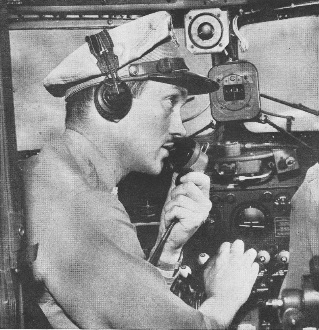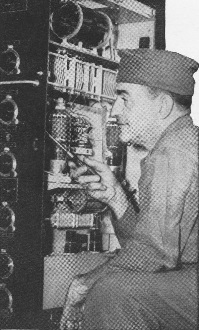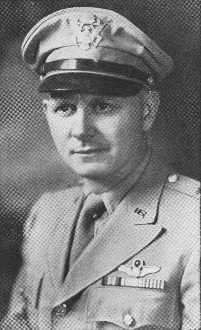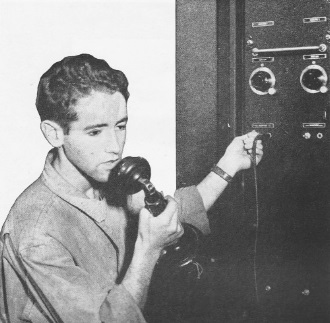|
The
Douglas DC-3
revolutionized commercial air travel with its introduction in 1935, and the military
version, the C-47 Skytrain (aka Dakota, aka Gooneybird), proved an invaluable
workhorse for the U.S. Army Air Force during World War II. Without reliable
and effective radio communications, the aircraft's success would have been much
less. Companies like Bendix Radio led the way with rugged avionics that could take
the harsh conditions of flight that include vibration, shock, pressure changes,
and temperature variations. Replacement parts were usually not conveniently on-hand
and the radio operator often needed to also be a trained electronics technician
or engineer. "Necessity is the mother of invention," never proved truer than during
wartime as evidenced by the many technology advances realized during the 1940s.
The DC-3 / C-47 is by far my favorite multi-engine passenger plane.
I have plans printed and balsa purchased for a
control line C-47 model that will have a 48" wingspan.
Communications on the World's Greatest Airline

 A C-47, called the workhorse of the Army
Air Forces, flies over the radio-control tower at the 2nd Ferrying Group's base
near Wilmington, Delaware. A C-47, called the workhorse of the Army
Air Forces, flies over the radio-control tower at the 2nd Ferrying Group's base
near Wilmington, Delaware.
By Lt. Col. Howard J. Haines, Adj. Gen. Ferrying Div., ATC
The Ferrying Division of the Air Transport Command has led the way in securing
the most modernized air-ground communications system.
Take a C-47, converted for evacuation transport, put it in the air between New
York and Nashville with a precious human cargo consisting of 10 litter patients
and 8 ambulatory cases, all recently returned from battlefields of Europe and bound
now for general hospitals near their homes, and you have a responsibility on your
hands which demands constant air-ground communications between the pilot and radio
stations along the route.
Remove the litters and the seats from the same plane, load it with vital engine
parts which must be rushed from Newark to Miami, Florida where the "Fireball Express"
will pick up the parts and carry them across Africa and Asia for delivery to the
battle fronts, and you would not want your strictly nonexpendable crew, plane, and
cargo to get lost on the way to Miami.
Put 21 seats back in the same plane, and fill them with highly trained pilots
and navigators who have just ferried planes from Detroit to Long Beach, California
and are now being returned to their home stations, and it would not be sound flying
procedure to be out of touch with the plane for very long - the cargo would be much
too valuable.
Do these three jobs every day of the week on 27 separate airlines, stretching
up and down these United States for more than 86,000 miles, and in doing them fly
1,000,000 ton miles a month and evacuate more than 6,500 wounded fighters per month
from coastal hospitals to hospitals near their homes, call the whole thing Military
Air Transport, and you would be operating just about the world's greatest airline,
and would need the world's finest air-ground radio communication system to make
sure that your planes would be able to fly around storms, avoid mountains, and arrive
at their destinations with clock-like regularity.
Late in May, 1944, the Ferrying Division of the Air Transport Command was called
upon by its parent organization to do those three jobs. It was directed by Air Transport
Command Headquarters in Washington, D. C., to take over eighteen air routes formerly
operated by private airlines in the United States.

Radio check and instructions are obtained from control tower
prior to takeoff.
The Ferrying Division, which is under the command of Brig. Gen. Bob. E. Nowland,
command pilot and veteran of 26 years with the Army Air Forces, was eminently equipped
from almost every standpoint to do the jobs.
From its Headquarters in Cincinnati, Ohio, it could call upon nine Ferrying Groups
for the planes and for the trained pilots and crews to operate them. Moreover, the
fliers were superbly trained, for they had long been performing such missions of
the Ferrying Division as ferrying planes from factories to the battle sectors, and
had been flying foreign transport routes reaching across ocean and desert for thousands
of miles, as far as India. There were mechanical crews handy to service the planes;
almost every imaginable essential for successful operation of such a group of military
air transport lines.
Only one thing was missing - adequate air-ground radio communications, facilities
for talking from plane to ground comparable to those in use by the commercial airlines.
True, the Army Airways Communications System, which functions under the Air Communications
Officer, who is a member of the Air Staff with Headquarters in Washington, had approximately
80 AACS stations set up throughout the country; but these stations were not equipped
to provide the same service as the air-ground stations maintained by commercial
airlines. Successful scheduled commercial operations hinge upon periodic voice communication
from plane to ground and vice versa, keep the aircraft virtually in constant contact
with the ground, and afford consequent flexibility of operation and a tremendous
safety factor.

Radio technician of the 2nd Ferrying Group tunes up a transmitter
unit.

Brigadier General Bob E. Nowland, Comm. General of the Ferrying
Division of the ATC.
There was only one solution if the Army Air Forces was going to operate efficient
military air transport lines within the United States. The Ferrying Division, designated
to do so, would have to lead the way to securing modernized air-ground communications
for the Army, comparable in every way to those used by the finest commercial air
lines.
The writer, who has the title of Adjutant General for the Ferrying Division,
but is also Director of Communications and Signal Officer and still likes to think
of the days when he was radio "ham" W2EIS, drew the job of forming a sort of flying
wedge, to use old time football parlance, which could smash through any potential
lines of delay and secure modern air-ground communications in a hurry.
Carrying the football analogy a yard or two further, it had been possible, fortunately,
to get the wedge force in shape with some "Spring training," during which fundamentals
were implanted which would lead to a speedy drive to the goal of modern air-ground
communications.
On March 9, 1944, a board from the office of the Air Communications Officer had
visited Ferrying Division Headquarters. The board was endeavoring to determine the
communications requirements of the entire Army Air Forces.
The members of the board were told that the Ferrying Division needed Army Airways
Communications System air-ground stations which would maintain the same standard
of efficiency as those operated by private airlines.
When, on May 25, the Ferrying Division actually assumed operation of the eighteen
airlines, and called them Military Air Transport, M-A-T for short, the new air-ground
stations were still nebulous and far from realization.
Soon, however, a conference was held in the office of Maj. Gen. Harold L. George,
Commanding General of the Air Transport Command. It was attended by representatives
of AACS, by a communications man from the Secretary of War's office, by representatives
of the Air Communications Office, and by high-ranking officers of the Ferrying Division.
At the conference, the air-ground communication needs, already known for the
most part because of the earlier visit by the board from the office of ACO, were
discussed in greater detail.

Radio specialist checks ground station transmitter with a call
to the tower.

A C-47 is shown landing at one of its airfields.

An invaluable aid to safe and efficient flying is this Bendix
transmitter-receiver. Specially-trained men are employed for the installation of
this type of equipment.
A short time later, a letter went forward from the Ferrying Division to Gen.
George, for the attention of his Assistant Chief of Staff in the Communications
Division of Operations, Lt. Col. W. D. Innes.
The letter set forth clearly the reasons why the Ferrying Division must have
air-ground radio stations. Maps were attached showing the routes to be flown, and
the number of aircraft to be flown on each route was indicated. It was suggested
that as many such stations as possible be put into operation immediately. Request
was made that each station be able to use two frequencies. In all, 47 stations were
requested.
The result was instant cooperation on the part of the Air Transport Command,
the Air Communications Office, and the Army Airways Communications System.
It was agreed that 47 modernized AACS stations would be set up along the M-A-T
routes to be operated by the Ferrying Division. It was also agreed that the identical
air-ground radio equipment used in commercial planes, the Bendix transmitter-receiver,
would be installed in all Ferrying Division transports as speedily as possible.
Work went forward immediately. In August, a new AACS ground-air radio station,
known as the New Castle airways station, opened at the 2nd Ferrying Group at Wilmington,
Delaware. Other stations, of course, had already been in operation, with older facilities
altered to meet present needs.
Installation of the Bendix receiver-transmitters went forward apace. By midsummer,
most of the planes flying under the M-A-T purple and brown Flying Hawk insignia
were equipped with this invaluable aid to safe and efficient flying.
Work is still in progress, but should be completed early in the fall of this
year, with all 47 AACS stations in full operation and every plane flown by M-A-T
equipped with the new equipment.
With this system in operation, it is possible for an M-A-T plane in flight anywhere
over the country, to communicate at any time directly with Ferrying Division Headquarters
in Cincinnati. The pilot of the plane talks to the nearest AACS station, which in
turn talks to the Headquarters of the Ferrying Group which is operating the M-A-T
route. The Ferrying Groups, evenly spaced throughout the United States, are connected
by land-line network with Headquarters of the Ferrying Division. Thus, the pilot
can at any time avail himself not only of the latest weather reports, but of advice
from the wisest heads in the business of flying.
In the first half of 1944 the Ferrying Division established a record of 40,000,000
ton miles over foreign routes.
Posted June 17, 2022
(updated from original post on
2/12/2015)
|

















